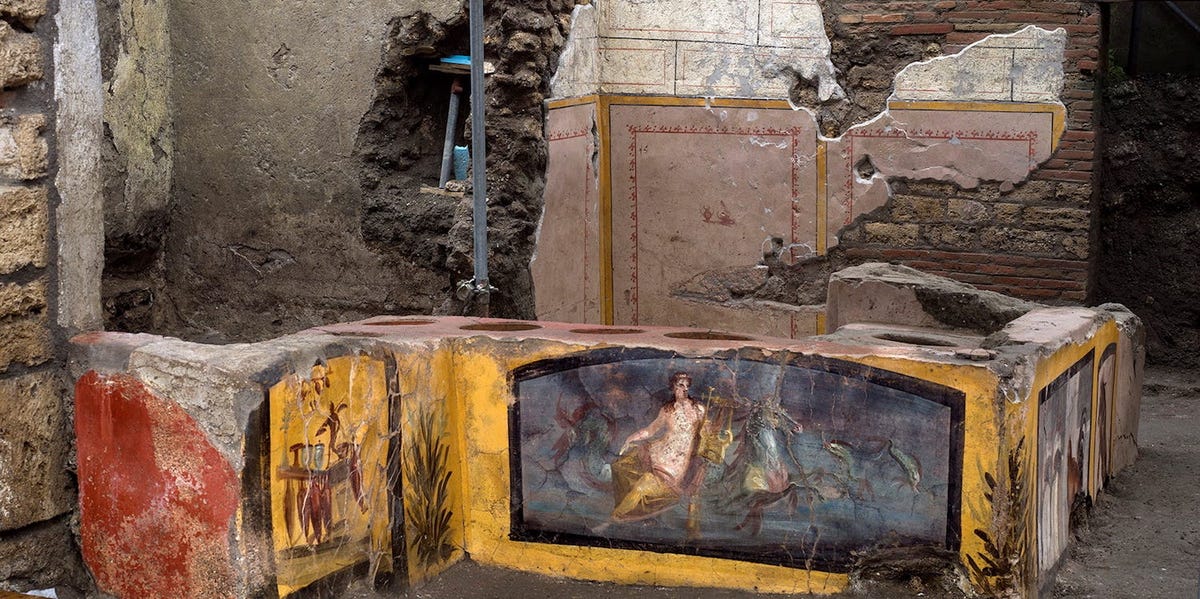Perhaps one of the most remarkable archaeological sites in the world, the excavations of Pompeii, have provided us with insight into the daily lives of civilians in the Roman Empire. Once a fishing port and hub for trade and industry, the famous eruption of Mount Vesuvius in 79AD buried the city in toxic gas, ash, and stone – leaving buildings, streets, and bodies of those going about their daily lives frozen in time. The recent excavation of a frescoed food and drink shop, known at the time as a thermopolium, features highly preserved art and food remains and provides an almost pristine example of how much our lives mirror those who lived 2000 years before us. Even the bright red and yellow theme of this fast-food restaurant is extremely familiar…
The counter features deep circular holes housing deep terracotta jars, once filled with hot food – much like the buffet set-up we have today. The type of food in each hole is labelled with the images of different meats. – an archaeologist added that “paintings on the counter include two mallard ducks, and indeed a fragment of duck bone was in fact found inside one of the containers, alongside pigs, goats, fish, and land snails, indicating the great variety of products of animal origin used in the preparation of the dishes.” These 2000-year-old food remains not only allow historians and anthropologists to understand the diet of an average Roman civilian, but also shows how and where meals were consumed. These food remains are particularly exciting because this is the first thermopolium to be fully excavated, which brings hope that the excavations of other thermopolia will have equally well-preserved treasures!

Much like the graffiti and doodles that are engraved on tables and walls of fast-food restaurants today, a scratched message can be seen on the top border of this Cave Canem fresco. It prominently features a dog on a lead, which serves as a warning since the inscription reads “Nicia cinaede cacator”, or rather “Nicias shameless sh*tter!”. Archaeologists assume that Nicias is the owner or a worker at this thermopolium. This cheeky inscription acts as the only marking that a man called Nicias ever existed; alas we will never know if the statement is accurate, but going by the comments I see engraved on tables or walls or today, I’m willing to believe that the statement made about Nicias probably has some truth to it!
In other amphorae (or rather large terracotta jars), fava beans were also found which modify the taste and colour of the wine by bleaching it. In total, nine amphorae, a bronze bowl, two flasks, and a ceramic table jar (called an olla, used to cook stews) were found in the thermopolium, presumably used by the many visitors to this pub before the sudden eruption of Mount Vesuvius.
There is something very profound about how such a wonderful example of civilian life, like this thermopolium, survived an eruption of toxic fumes, ash, and pumice that is comparable to an atomic bomb. The well-preserved frescoes and inscriptions that we view today, after 2000 years, must have been familiar sights to the long-gone visitors of this thermopolium… Discoveries like these, particularly during lockdown, present a poignant reminder of how innately human it is to want to socialise: to go to the pub, hang out with mates, and share a meal. Despite the many differences and challenges humanity has experienced over the last two centuries, the idea that we are, and always will be, social creatures has never been emphasised so much as it is today.
By Tharushi Wijesiri
Header image: Insider.

